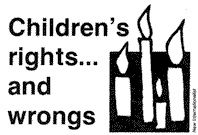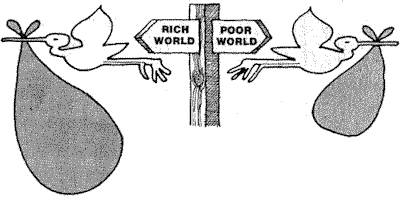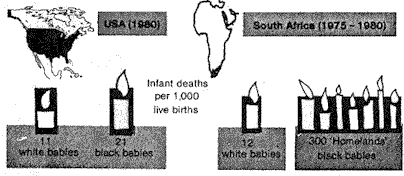 |
 "The
death of one child, when that death could have been avoided, is a rebuke to all
humanity." "The
death of one child, when that death could have been avoided, is a rebuke to all
humanity."
Javier Perez de Cuellar, UN Secretary General 1986
|
More children die because they are improperly
weaned than because of famine.
More children die because their parents do not
know how to manage diarrhoea than because of epidemics.
More children die because their mothers have no
wells, hoes or purchasing power than because of war.
And when children are stunted and retarded from disease and
malnutrition, when overburdened parents cannot generate wealth for education and
development ... these stresses perpetuate drought, disease and famine.  Worldwatch Paper 64 Worldwatch Paper 64
Bottle fed babies are three times as likely to get diarrhea and
twice
as likely to catch respiratory infections (the two main causes of infant death) as breast
fed babies.  New Internationalist New Internationalist
In very poor countries, children may be ill for 30% to 50% of their young lives.  State of the World's Children
1986 State of the World's Children
1986
A study of 25 countries showed that giving all mothers 7 or more years of education
lowered infant and child mortality by an average of 41%.  New Internationalist New Internationalist
A relatively small amount of extra food each day, for at-risk pregnant women, has been
shown to reduce the incidence of low-birthweight which is universally, and in all
population groups, the single most important determinant of the chances of the newborn to
survive and to experience healthy growth and development.  State of the World's Children
1986 State of the World's Children
1986
Looking after Mothers If mothers are this important to the welfare of children, it should
be obvious that their physical and mental well-being should be safeguarded. But the reality is different. Fatigue is the commonest chronic health problem for
women - not surprisingly. In the poor world, women produce at least 50% of the food,
as well as being responsible for all the domestic tasks. Childbearing adds a third
workload; by the age of 30, a women has often spent 80% of her adult life pregnant or
breastfeeding. Hard work, childbearing and undernourishment lead to anemia. In
poor countries, half of all women, and two thirds of pregnant women, are anemic. The value of women's unpaid labour in industrialised countries is estimated as 25 - 40% of
GNP. In the world as a whole, it is estimated as one -third of the world's economic
product.
Discriminate Death
Discrimination by wealth begins even before birth.
Poor, undernourished mothers are more likely to give birth to undernourished babies - and
small, weak babies are more susceptible to illness and death. Low birthweight babies are 4 - 6 times more susceptible to physical and mental handicap,
and 8 - 10 times more likely to die in the first year of life.

More than 23 million babies a year are born weighing less
than 2,500 grammes (approx. 5.5 pounds); 90% of these are born in the developing world...
where one child in four is also seriously undernourished. But even in the richest countries babies are not safe from the effects of poverty.
If a baby is born into a family kept poor by race or class discrimination, the baby's
chances of survival shrink.

Sex discrimination kills, too. If a baby is not just poor and
black, but a girl, her chances of survival dwindle further. Girl babies are biologically
stronger than boys, so at birth and earliest infancy, girls' death rates are often lower
than boys'.
But then discrimination in favour of boys takes over, and
the girls' death rate begins to surpass the boys'.
| |
Ratio of
deaths
at birth |
Ratio of
deaths
Aged 1 - 4 Years |
| |
Boys |
Girls |
Boys |
Girls |
| Bangladesh |
100 |
93 |
100 |
112 |
| Barbados |
100 |
91 |
100 |
200 |
| S. Korea |
100 |
86 |
100 |
105 |
Vaccine-preventable diseases kill a
total of 3,450,000 children each year in the developing world.  State of the World's Children
1986 State of the World's Children
1986
The cost of protecting children against measles, tetanus,
whooping cough and other childhood diseases is approximately $5 per child
Regular growth-checking, along with changes in the method
and timing of weaning could reduce by half the incidence and severity of malnutrition
among the world's poor children.
The real problem is not either infection or malnutrition,
but both - as malnutrition itself predisposes the child to some infections which lead to
further nutritional depletion.
 State of the World's Children 1986 State of the World's Children 1986
In affluent America, poverty is the greatest child killer. More children die each year
from poverty than from traffic fatalities and suicide combined. Twice as many die from
poverty than from cancer and heart disease combined.  Black & White Children in
America Black & White Children in
America
By 1990, if current administration budget priorities succeed, every American will be
spending 19% less on poor children and families and 86% more on the military.
In the US, almost half of all black children are poor. One white child in 6 is poor.
Children make up 36.6% of the white population living in poverty. They comprise an even
larger proportion of the poor black population. Over 4 of every 10 poor black are
children.  Black & White Children in
America Black & White Children in
America
$800 million a day, $33 million an hour, $555,000 a minute goes to the US Military Budget.
One minute's worth of military spending world pay for the 14,000 monthly WIC food packages
to feed pregnant women and infants that was cut from the US budget in 1985.  Black & White Children in
America Black & White Children in
America
SOURCES:
Black and White Children in America: Key Facts, 1985,
Children's Defense Fund, 122 C Street, NW, Washington, D. C. 20001
The New Internationalist, No. 164, October 1986, New
Internationalist Publications, 175 Carlton St., Toronto, Ontario, Canada M5A 2K3; for
subscription enquiries P. O. Box 255, Lewiston, NY 14092.
The State of the World's Children 1986, UNICEF, Division
of Communications and Information, 866 UN Plaza, New York, NY, 10017
Worldwatch Paper 64: Investing in Children, 1985,
Worldwatch Institute, 1776 Massachusetts Avenue, NW, Washington, DC 20036.
Produced by the Office on Global Education, National
Council of Churches, 2115 N. Charles St., Baltimore, MD 21218-5755
A program of the Divisions of Education and Ministry, and Church World Service
|